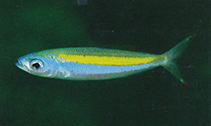| Family: |
Caesionidae (Fusiliers), subfamily: Caesioninae |
| Max. size: |
9.75 cm SL (male/unsexed) |
| Environment: |
pelagic-neritic; marine; depth range 0 - 55 m |
| Distribution: |
Western Pacific: Cenderawasih Bay, Indonesia. |
| Diagnosis: |
Dorsal spines (total): 10-10; Dorsal soft rays (total): 14-16; Anal spines: 3-3; Anal soft rays: 11-12. This species is distinguished by the following set of characters: 2 post-maxillary processes; D X,14-15 (usually 15); A III, 11-12 (usually 12); pectoral rays 20-21(usually 20); lateral-line scales 72-80 (modally 74); scales above lateral line to origin of dorsal fin 6-7 (usually 7); scales below lateral line to origin of anal fin 12-14 (usually 13); circumpeduncular scales, anterior modally 12.14, ventral modally 14.71; body is fusiform in shape and extremely elongate for the genus, greatest depth 4.3-5.1 in SL; HL 3.2-3.6 in SL; snout 4.0-5.2 in HL; eye 2.9-3.6 in HL; pectoral-fin length 1.2-1.4 in HL; in life, color blue, grading to silvery white on belly, with prominent, broad yellow stripe on upper side from dorsal posterior margin of operculum to upper half of caudal peduncle, covering maximum of four scale rows, centered just above lateral line, except entirely above it on caudal peduncle; tip of each caudal-fin lobe with reddish spot (often appearing black underwater), before this is a whitish area (Ref. 74965). |
| Biology: |
A common species, occurring in large schools with up to several hundred individuals. Observed to be frequently mixed with Pterocaesio pisang and Gymnocaesio gymnopterus. Often occurs on the upper edge of seaward reef slopes, commonly at depths ranging from the surface to about 15 m, but also sighted as deep as 55 m. Unlike other caesionids, when pursued, it hides in nearby crevices and holes within the reef matrix (Ref. 74965). |
| IUCN Red List Status: |
Not Evaluated (N.E.) Ref. (130435)
|
| Threat to humans: |
harmless |
Source and more info: www.fishbase.org. For personal, classroom, and other internal use only. Not for publication.
